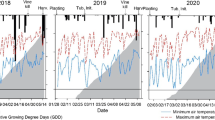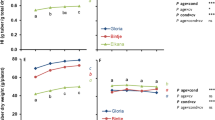Abstract
Tuber initiation and development are processes basic to potato production and are particularly critical in areas with short growing seasons. It is important to know how and to what extent management decisions affect these processes in order to maximize the yield of marketable tubers. A two-year field study, conducted in southcentral Alaska, examined top growth, tuber initiation, and tuber development in eight potato cultivars grown with and without irrigation. Plants of the cultivars Allagash Russet, Bake-King, Green Mountain, Kennebec, Lemhi Russet, Russet Burbank, Shepody, and Superior were harvested weekly throughout the growing season, and top dry weight, numbers of tubers, and individual tuber fresh weights were recorded. Top dry weight was reduced by moisture stress shortly after emergence in 1993, and about one month following emergence in 1994, when early-season soil moisture was greater. The weight of tubers was similarly affected within approximately 5 wk of emergence in 1993 and 6 weeks in 1994. Tuber weight at harvest was increased two-to three-fold by irrigation in all cultivars. The number of tubers each plant set was affected by irrigation in most, but not all, cultivars. Some varieties (Lemhi Russet in 1994, Allagash Russet both years) set more tubers than were maintained through the growing season. Tuber remnants found during sample collection indicated that tuber reabsorption had occurred. Irrigated Green Mountain had more than one tuber initiation period during the season, whereas other varieties such as Shepody maintained a relatively constant number of tubers following initial tuber set. Tuber size distribution at the end of the growing season showed that larger tubers were favored by irrigation.
Resumen
El inicio y desarrollo de la tuberización son procesos básicos para la producción de papa, y son particularmente críticos en áreas con una corta temporada de crecimiento. Es importante conocer cómo y qué decisiones de manejo afectan dicho proceso con el fin de maximizar el rendimiento de los tubérculos con valor comercial. Un estudio de campo de dos anos, realizado en el centra y sur de Alaska, examinó el crecimiento de los brotes, el inicio de la tuberización y su desarrollo en ocho cultivares con y sin irrigación. Plantas de las variedades Allagash Russet, Bake-King, Green Mountain, Kennebec, Lemhi Russet, Russet Burbank, Shepody y Superior fueron cosechadas semanalmente durante la temporada de crecimiento, registrándose el peso seco de los brotes, el numero de tubérculos y el peso individual de los tubérculos frescos. El peso seco de los brotes se redujo por estrés de humedad poco después de la emergencia en 1993, y cerca de un mes después de la emergencia en 1994, cuando la humedad del suelo al principio de la temporada fue mayor. El peso de los cultivares fue afectado en forma similar durante las cinco semanas de emergencia en 1993 y seis semanas en 1994. El peso de los tubérculos a la cosecha se incrementó dos a tres veces por irrigación en todos los cultivares. El numéro de tubérculos de cada planta fue afectado por la irrigación en la mayor parte, pero no en todos los cultivares. Algunas variedades (Lemhi Russet en 1994, Allagash Russet en ambos años) fijaron más tubérculos que fueron mantenidos durante la estación de crecimiento. Los tubérculos remanentes encontrados durante la recolección de la muestra indicaron que habia ocurrido una reabsorción de tubérculos. La variedad irrigada Green Mountain ténia más de un tubérculo en el periodo de inicio de tuberización durante la temporada, mientras que otras variedades, como Shepody, mantuvieron un numéro de tubérculos relativamente constante después de la fijación de la tuberización inicial. La distribución del tamaño de los tubérculos hacia el fin de la estación de crecimiento demostro que los tubérculos más grandes fueron favorecidos por la irrigación.
Similar content being viewed by others
Literature Cited
Clark, C.F. 1921. Development of tubers in the potato. Rep. No. 958. USDA.
Dearborn, C.H. 1981. Observations on plant and tuber growth of potato in Alaska. University of Alaska Agricultural Experiment Station Bulletin 57.
Dwyer, L.M., and J.B. Boisvert. 1990. Response to irrigation of two potato cultivars (Solanum tuberosum L. ‘Kennebec’ and ‘Superior’). Can Agric Engr 32: 197–203.
Haverkort, A.J., M. Van de Waart, and K.B.A. Bodlaender. 1990. The effect of early drought stress on numbers of tubers and stolons of potato in controlled and field studies. Potato Res 33: 89–96.
Hide, G.A., and S.J. Welham. 1992. Observations on the bulking and development of tuber size distribution in maincrop potatoes at Rothamsted in 1964–75. Potato Res 35: 235–247.
Krijthe, N. 1955. Observations on the formation and growth of tubers on the potato plant. Neth J Agric Sci 3: 291–304.
Mackerron, D.K.L., and R.A. Jefferies. 1986. The influence of early soil moisture stress on tuber numbers in potato. Potato Res 29: 299–312.
Mackerron, D.K.L., and R.A Jefferies. 1988. The distributions of tuber sizes in draughted and irrigated crops of potatoes I. Observations on the effect of water stress on graded yields from differing cultivars. Potato Res 31: 269–278.
Meredith, P. 1988. The development and properties of the tuber of the potato (Solanum tuberosum L.). Part 2: The pattern of growth in the field: Bolbography. Starch/Starke 40: 369–374.
Regel, P.A., and P.J. Sands. 1983. A model of the development and bulking of potatoes (Solanum tuberosum L.). IV. Daylength, plant density and cultivar effects. Field Crops Res 6: 1–23.
Sands, P.J., C. Hackett, and H.A. Nix. 1979. A model of the development and bulking of potatoes (Solanum tuberosum L.). I. Derivation from well-managed field crops. Field Crops Res 2: 309–331.
Struik, P.C., A.J. Haverkort, D. Vreugdenhil, C.B. Bus, and R. Dankert. 1990. Manipulation of tuber-size distribution of a potato crop1. Potato Res 33: 417–432.
Author information
Authors and Affiliations
Corresponding author
Rights and permissions
About this article
Cite this article
Walworth, J.L., Carling, D.E. Tuber initiation and development in irrigated and non-irrigated potatoes. Am. J. Pot Res 79, 387–395 (2002). https://doi.org/10.1007/BF02871683
Accepted:
Issue Date:
DOI: https://doi.org/10.1007/BF02871683




